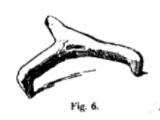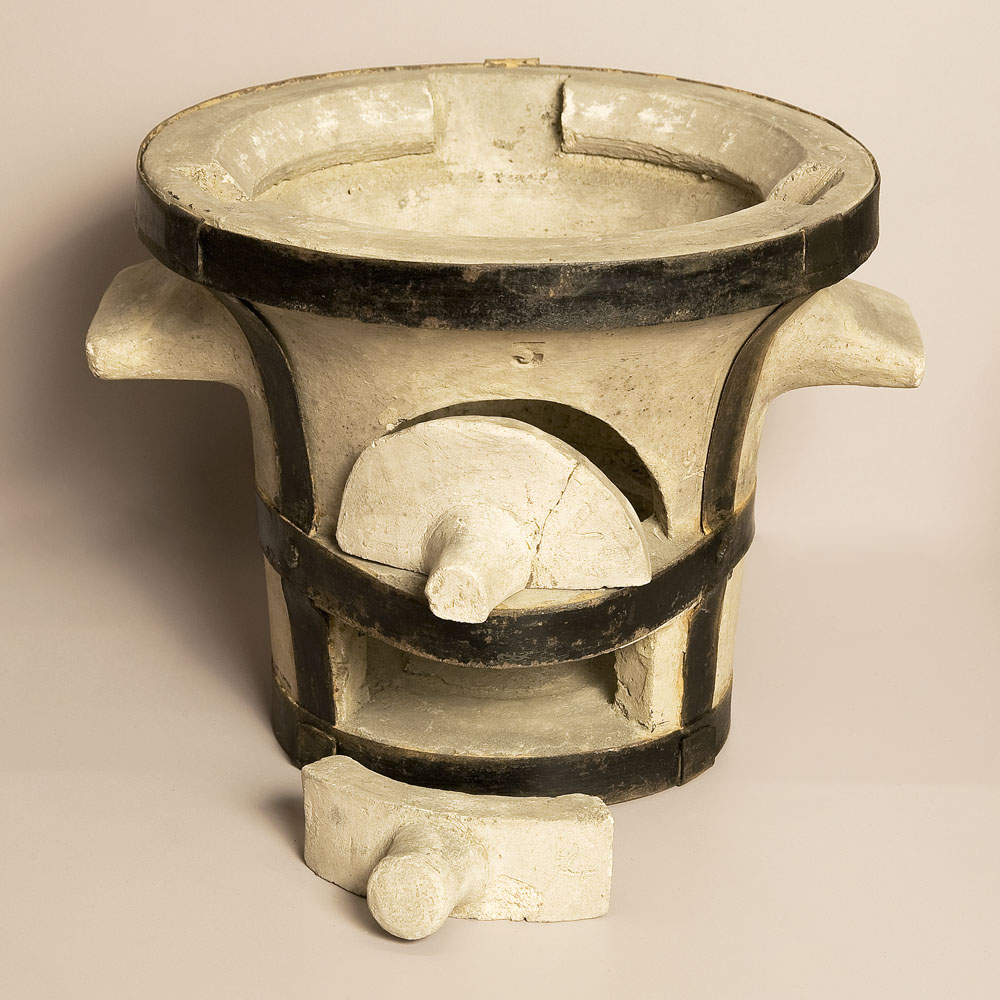|
Kiln Furniture
Kiln furniture are devices and implements inside furnaces used during the heating of manufactured individual pieces, such as pottery or other ceramic or metal components. Kiln furniture can account for up to 80% of the mass of a kiln charge. Materials Commonly used materials are cordierite (up to 1275 °C), mullite (up to 1750 °C), silicon carbide (up to 1500 °C), alumina (up to 1750 °C), zirconia (up to 1650 °C). The choice depends on cost, weight, and physical properties. Functions and effects Functions of kiln furniture include carrying the kiln/furnace (other), furnace load and protecting the load from various kind of damage: open file, smoke, debris, from deforming or sticking the components to each other. In addition to various carriers and plates, capsules with heating material may be used. Kiln furniture influences the heat distribution in the furnace and the interaction of the load with the atmosphere in the furnace. Since the furni ... [...More Info...] [...Related Items...] OR: [Wikipedia] [Google] [Baidu] |
Kiln Furniture Before Glost FIring
A kiln is a thermally insulated chamber, a type of oven, that produces temperatures sufficient to complete some process, such as hardening, drying, or chemical changes. Kilns have been used for millennia to turn objects made from clay into pottery, tiles and bricks. Various industries use rotary kilns for pyroprocessing (to calcinate ores, such as limestone to lime for cement) and to transform many other materials. Etymology According to the Oxford English Dictionary, kiln was derived from the words cyline, cylene, cyln(e) in Old English, in turn derived from Latin ''culina'' ('kitchen'). In Middle English, the word is attested as kulne, kyllne, kilne, kiln, kylle, kyll, kil, kill, keele, kiele. In Greek the word ''καίειν, kaiein'', means 'to burn'. Pronunciation The word 'kiln' was originally pronounced 'kil' with the 'n' silent, as is referenced in ''Webster's Dictionary of 1828'' and in ''English Words as Spoken and Written for Upper Grades'' by James A. Bowe ... [...More Info...] [...Related Items...] OR: [Wikipedia] [Google] [Baidu] |
Furnace (other)
Furnace may refer to: Appliances Buildings * Furnace (central heating): a furnace, or a heater or boiler, used to generate heat for buildings * Boiler, used to heat water; also called a furnace in American English when used for heating and hot water in a building * Jetstream furnace or Tempest boiler, a design of wood-fired water heater Industry * Industrial furnace, a device used in industrial applications ** Glass melting furnace ** Muffle furnace or retort furnace ** Solar furnace ** Vacuum furnace * Metallurgical furnace, a device used to heat metal and metal ore ** Basic oxygen furnace ** Bessemer converter ** Blast furnace ** Bloomery ** Electric arc furnace ** Induction furnace ** Open hearth furnace ** Puddling furnace ** Reverberatory furnace Places United Kingdom * Furnace, Argyll, Scotland, a village * Furnace, Carmarthenshire, Wales, a village * Furnace, Ceredigion, Wales, a village United States * Furnace, California, a former settlement * Furnace, Indiana, a smal ... [...More Info...] [...Related Items...] OR: [Wikipedia] [Google] [Baidu] |
Pottery
Pottery is the process and the products of forming vessels and other objects with clay and other raw materials, which are fired at high temperatures to give them a hard and durable form. The place where such wares are made by a ''potter'' is also called a ''pottery'' (plural ''potteries''). The definition of ''pottery'', used by the ASTM International, is "all fired ceramic wares that contain clay when formed, except technical, structural, and refractory products". End applications include tableware, ceramic art, decorative ware, toilet, sanitary ware, and in technology and industry such as Insulator (electricity), electrical insulators and laboratory ware. In art history and archaeology, especially of ancient and prehistoric periods, pottery often means only vessels, and sculpture, sculpted figurines of the same material are called terracottas. Pottery is one of the Timeline of historic inventions, oldest human inventions, originating before the Neolithic, Neolithic period, w ... [...More Info...] [...Related Items...] OR: [Wikipedia] [Google] [Baidu] |
Stilt (ceramics)
Stilts are small supports used when firing glazed ceramic A ceramic is any of the various hard, brittle, heat-resistant, and corrosion-resistant materials made by shaping and then firing an inorganic, nonmetallic material, such as clay, at a high temperature. Common examples are earthenware, porcela ...s to stop the melting glaze from fusing them to each other or the kiln. Stilts are a form of kiln furniture. Their presence in archaeological sites, where they may be known as pernette, along with other kiln furniture such as saggars and kiln bars can be used to support a case for local production. Some potters avoid the need for stilts by not glazing the bottom of their products. This is known as dry footing. History Various types of stilts have been developed over the centuries: Tripod stilt The tripod stilt, which has three legs with a raised point on each end, appears to have been developed in China at least as far back as the third century AD. Tripod stilts have ... [...More Info...] [...Related Items...] OR: [Wikipedia] [Google] [Baidu] |
Pernette
Stilts are small supports used when firing glazed ceramics to stop the melting glaze from fusing them to each other or the kiln. Stilts are a form of kiln furniture. Their presence in archaeological sites, where they may be known as pernette, along with other kiln furniture such as saggars and kiln bars can be used to support a case for local production. Some potters avoid the need for stilts by not glazing the bottom of their products. This is known as dry footing. History Various types of stilts have been developed over the centuries: Tripod stilt The tripod stilt, which has three legs with a raised point on each end, appears to have been developed in China at least as far back as the third century AD. Tripod stilts have been found during excavations in Ur. It was adopted by the Islamic world in the 9th century AD and was later adopted by the Byzantines around the start of the 13th century. The use of this stilt can be deduced from damage to the glaze where the three rai ... [...More Info...] [...Related Items...] OR: [Wikipedia] [Google] [Baidu] |
Fireclay
Fire clay is a range of refractory clays used in the manufacture of ceramics, especially fire brick. The United States Environmental Protection Agency defines fire clay very generally as a "mineral aggregate composed of hydrous silicates of aluminium (Al2O3·2SiO2·2H2O) with or without free silica." Properties High-grade fire clays can withstand temperatures of 1,775 °C (3,227 °F), but to be referred to as a "fire clay" the material must withstand a minimum temperature of .Minerals Zone, World Mineral Exchange. Retrieved 2011-6-23. Fire clays range from '' flint clays'' to ''plastic fire clays'', but there are ''semi-flint'' and ''semi-plastic'' fire clays as well. Fire clays consist of natural [...More Info...] [...Related Items...] OR: [Wikipedia] [Google] [Baidu] |
Saggar
A saggar (also misspelled as sagger or segger) is a type of kiln furniture. It is a ceramic boxlike container used in the firing of pottery to enclose or protect ware being fired inside a kiln. The name may be a contraction of the word ''safeguard''. Saggars are still used in the production of ceramics to shield ware from the direct contact of flames and from damage by kiln debris. Traditionally, saggars were made primarily from fireclay. Saggars have been used to protect, or safeguard, ware from open flame, smoke, gases and kiln debris: Modern saggars are made of alumina ceramic, cordierite ceramic, mullite ceramic, silicon carbide and in special cases from zirconia. Ming porcelain The manufacturer of saggars in the fifteenth and sixteenth centuries occupied a large proportion of space, labour and material (fuel and clay) at the imperial manufactury, and there were more kilns devoted to creating them than to firing the final product. Staffordshire potbanks By far the larg ... [...More Info...] [...Related Items...] OR: [Wikipedia] [Google] [Baidu] |
Gladstone Biscuit Bottle Oven 3811
William Ewart Gladstone ( ; 29 December 1809 – 19 May 1898) was a British politican, starting as Conservative MP for Newark and later becoming the leader of the Liberal Party. In a career lasting over 60 years, he was Prime Minister of the United Kingdom for 12 years, spread over four non-consecutive terms (the most of any British prime minister) beginning in 1868 and ending in 1894. He also was Chancellor of the Exchequer four times, for over 12 years. He was a Member of Parliament (MP) for 60 years, from 1832 to 1845 and from 1847 to 1895; during that time he represented a total of five constituencies. Gladstone was born in Liverpool to Scottish parents. He first entered the House of Commons in 1832, beginning his political career as a High Tory, a grouping that became the Conservative Party under Robert Peel in 1834. Gladstone served as a minister in both of Peel's governments, and in 1846 joined the breakaway Peelite faction, which eventually merged into the new ... [...More Info...] [...Related Items...] OR: [Wikipedia] [Google] [Baidu] |
Kiln
A kiln is a thermally insulated chamber, a type of oven, that produces temperatures sufficient to complete some process, such as hardening, drying, or Chemical Changes, chemical changes. Kilns have been used for millennia to turn objects made from clay into pottery, Tile, tiles and bricks. Various industries use rotary kilns for pyroprocessing (to calcinate ores, such as limestone to Lime (material), lime for Cement kiln, cement) and to transform many other materials. Etymology According to the Oxford English Dictionary, kiln was derived from the words cyline, cylene, cyln(e) in Old English, in turn derived from Latin ''culina'' ('kitchen'). In Middle English, the word is attested as kulne, kyllne, kilne, kiln, kylle, kyll, kil, kill, keele, kiele. In Greek the word ''καίειν, kaiein'', means 'to burn'. Pronunciation The word 'kiln' was originally pronounced 'kil' with the 'n' silent, as is referenced in ''Webster's Dictionary of 1828'' and in ''English Words as Sp ... [...More Info...] [...Related Items...] OR: [Wikipedia] [Google] [Baidu] |
Pottery
Pottery is the process and the products of forming vessels and other objects with clay and other raw materials, which are fired at high temperatures to give them a hard and durable form. The place where such wares are made by a ''potter'' is also called a ''pottery'' (plural ''potteries''). The definition of ''pottery'', used by the ASTM International, is "all fired ceramic wares that contain clay when formed, except technical, structural, and refractory products". End applications include tableware, ceramic art, decorative ware, toilet, sanitary ware, and in technology and industry such as Insulator (electricity), electrical insulators and laboratory ware. In art history and archaeology, especially of ancient and prehistoric periods, pottery often means only vessels, and sculpture, sculpted figurines of the same material are called terracottas. Pottery is one of the Timeline of historic inventions, oldest human inventions, originating before the Neolithic, Neolithic period, w ... [...More Info...] [...Related Items...] OR: [Wikipedia] [Google] [Baidu] |
Sic Kiln Shelves
The Latin adverb ''sic'' (; ''thus'', ''so'', and ''in this manner'') inserted after a quotation indicates that the quoted matter has been transcribed or translated as found in the source text, including erroneous, archaic, or unusual spelling, punctuation, and grammar. ''Sic'' also applies to any surprising assertion, faulty reasoning, or other matter that might otherwise be interpreted as an error of transcription. The typical editorial usage of ''sic'' is to inform the reader that any errors in a quotation did not arise from editorial errors in the transcription, but are intentionally reproduced as they appear in the source text being quoted; thus, ''sic'' is placed inside brackets to indicate it is not part of the quotation. ''Sic'' can also be used derisively to direct the reader's attention to the writer's spelling mistakes and erroneous logic, or to show disapproval of the content or form of the material. Etymology and historical usage In the English language, the Lati ... [...More Info...] [...Related Items...] OR: [Wikipedia] [Google] [Baidu] |







